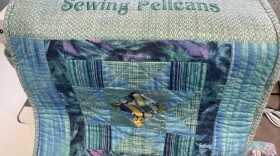A person’s body language, gestures and facial expressions provide important clues about how they’re feeling and what’s on their mind. For as long as he can remember, local artist Daniel Venditti has tried to capture these nuances in his portraits and figurative work. But the 32 paintings in his solo show this November at the Sidney & Berne Davis Art Center are called “Enigma” for an additional reason.
“When you see all the work together, you’ll find something that you’ll like, you’ll find something that you might not like, and that’s kind of the riddle,” said Venditti. “How does this all fit together? What does this mean to the viewer? What do they think it meant to me?”
Implicit in his work is permission for the viewer to draw their own conclusions.
“I don’t really like to explain my work,” Venditti conceded. “I’m happy to, but I enjoy what people think about it just figuring it out for themselves and how it affects them, and how it reflects back on them and what they’re seeing. So, again, part of the reason I chose the word ‘enigma.’”
Venditti does provide clues in the title he’s given to each painting, such as “Fortune Teller” or “Tug of War.” He concedes there’s something else at play that surprised him.

“After I kind of completed most of the work, I started looking at it and there’s a sense of isolation,” he said, lifting a brow in surprise.
Although Venditti has the support of a loving wife and two daughters, he lost his father in the middle of preparing for the show. Loss, mortality and a newfound concern about the mark he is leaving in the world permeate the paintings in this show.

“I think everybody feels that,” said Venditti. “I think everyone confronts that at some point in their life. I hope it resonates with them. They see it in the work. It’s also about life and joy and moving on. I hope they see that, too. It’s not all doom-and-gloom. A life-affirming thing came out of [the loss of my father] too.”
Venditti hopes that everyone who sees “Enigma” has some takeaway, and that certain pieces move them.
“That would make me extremely happy,” Daniel said, surrounded by the paintings he brought to the Davis Art Center to share with collectors, friends and those who haven’t previously viewed his work.
MORE INFORMATION:
“Enigma” opens November 1 in the Grand Atrium of the Sidney & Berne Davis Art Center in downtown Fort Myers with a 6 to 10 p.m. reception that is co-extensive with Fort Myers Art Walk.
The second floor Capital Gallery will exhibit artwork by Whitney Hackett.
SBDAC will also feature dance music by DJ Julz from 7 to 11 p.m. in Sidney’s Rooftop Sculpture Garden.
There is a story in each piece which is different for each viewer. “Enigma” challenges the viewer to find the meaning — their meaning — in each piece.
Each figure represents an aspect of the human condition — anger, happiness, fear, confidence, sensuality — or a combination of any of these emotions.

Venditti expresses his deepest thoughts, greatest joys, and darkest fears through figurative artwork. He states that the human face, gestures and bearing of one’s body speaks to us in life and art.
Venditti’s work varies depending on the media. His paintings are figurative in nature as well as introspective and autobiographical. His sculptures are immediate and abstract. His printworks tend to fall somewhere between his two styles through graphic figure and portraiture. His body of work is personal, reflecting what moves him emotionally. How a piece turns out is determined by the medium.
Art has always helped Vendetti process the raw emotions he feels.
His fascination with the human form, human nature, and his culture led to the discovery and development of his artistic style, leading with the intention to make ties between himself, the subject, and the observer.
His Italian heritage, coupled with past and contemporary European masters, also influenced his artistic style.

In some of the work in “Enigma,” Venditti tries to come to terms with events that are happening in America, and across the globe. One of these pieces is a four-panel painting titled “Tug of War.” It references the war in Ukraine, Gaza and other hotspots around the world.

“There’s a follow-up piece called ‘The Quiet,’” Venditti added. “This companion piece reflects what happens after the war’s over and we go home.”
Venditti received his bachelor's degree in fine art from Pratt Institute in 1987. He later attended the New York Academy of Art and received his master's in painting and sculpture in 1994.
Daniel apprenticed with Russian artists Komar and Melamid for most of the '90s, working on print editions of DEATH Magazine and its “America’s Most Wanted” series of paintings.
Matriculating from the Pratt Institute and this apprenticeship, Venditti is classically trained, which means that he does studies, sketches his subject on a gesso-prepared canvas and blocks in an underpainting before proceeding to the finished work.
But there’s a wrinkle in some of the pieces in this show.
“I kind of discovered slightly different things in [the process of preparing the pieces for this exhibition],” Venditti remarked. “I really liked some of the underpaintings that I was doing and I stopped wanting to cover them up completely with paint. So I came up with a different look toward the end of the body of work that you’ll see, where a lot of the drawing, a lot of the underpainting is still coming through, and I coupled that with a graphic background to kind of play off of that with a little bit of fun brushwork on top of a colorful standard background.”

“In addition to the 32 pieces in the Grand Atrium, there will be an entire room [the East Conservatory] of just drawings,” said Venditti. “I kind of wanted to show the process this time of some of the preliminary sketches, but also just some figurative sketches that are accessible. There’s nothing to figure out.”
They also provide collectors with options that are more affordable than the paintings included in the exhibition.
Venditti spent 20 years in New York City, showing his work in various galleries in the city as well as international galleries and group shows.
Venditti is currently living in Southwest Florida, where his work is evolving, combining his time in New York with the aesthetics of his new surroundings. He is involved in many local nonprofit and charitable organizations in the area. He also enjoys writing and poetry, basing some of his visual works on pieces he has written.
“Enigma” is on display through November 27, 2024.







